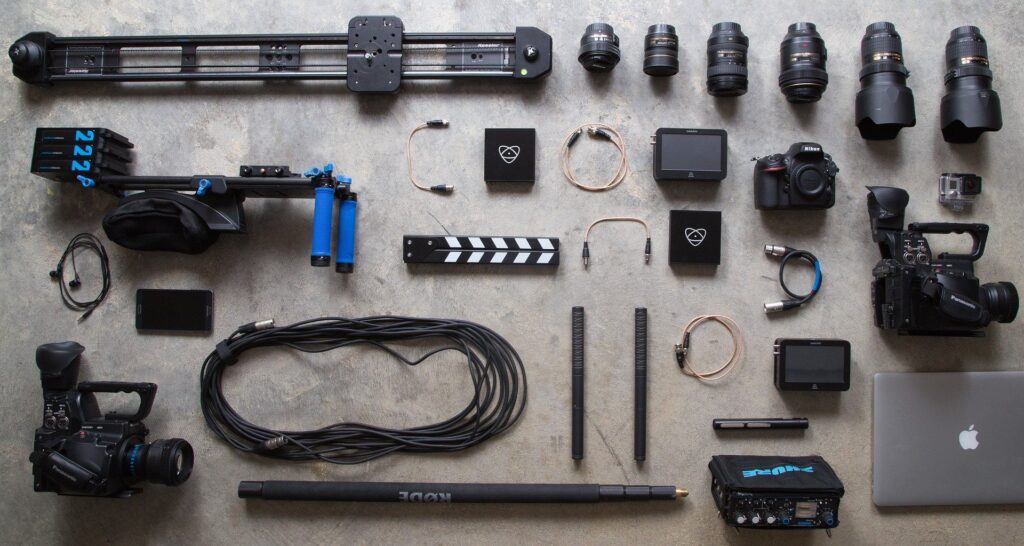Camera rental businesses have flashed up around the world in recent years, and the industry isn’t showing any signs of slowing down. With some of the most specialist equipment of any rental niche, there are a wealth of different ways to either focus or expand your camera rental business. You’re here, we suspect, either because you want to start a camera rental company or you already have.
Recently, Rentrax has tried to write as many helpful guides as possible. We have written guides on how to start a bike rental business, how to start a party rental business, and even how to create a business model for a rental business. As rental equipment software specialists, we are privileged to work with various equipment rental companies, including several camera rental businesses. We decided it might be useful for some readers to create a guide to starting a camera rental company. We can’t possibly cover everything in this article, but we’d like to offer some helpful information and hopefully inspire a few readers.
Spend Time Defining Your Market and Your Product Offering
This first part is arguably the most important, as it will influence every other aspect of your business. While you probably already have a strong idea of which kinds of cameras you plan to rent, it would serve you well to consider the market in your area and whether it would be better to either broaden your inventory range or focus on a more specific niche. Of course, your personal expertise will influence this decision, but consider the market in your area and be willing to slightly change your vision to appeal to the largest or most lucrative audience possible. Consider whether your target audience needs basic or high-end camera equipment — or perhaps something in between.
This decision will influence the name of your company, your brand identity, your website, and your marketing efforts. If, after a lot of deliberation, you are struggling to commit to just one target demographic, make sure your brand has enough broad appeal to allow you to lean into a particular market later on.
Avoid Idle Inventory

Remember this: it is always easier (and cheaper) to buy more camera inventory as needed than buying lots of inventory you don’t need that simply sits idle. When investing in inventory for your camera rental business, make sure you invest carefully. Early on, buy only the essential equipment — the cameras and accessories guaranteed to be in high demand. Then, over time, add more to your offering when it’s more comfortable. If you have a good feedback system on your website or in your physical store, ask customers if there are any products they would like to see in your inventory; collecting many different answers will reveal trends and preferences you may be unable to predict otherwise.
The Website is a Crucial Component for all Camera Rental Companies
Even if you intend to have a great physical store for customers to visit in person, you will need a high-quality website. This is because people tend to check the availability of camera equipment before going to the effort of visiting a store. Even if you don’t opt for a booking feature on your website (although we’d advise that you do), you will need a great-looking website that is easy to navigate. And if your business operates primarily online, then your website is your entire store, and you need to carefully consider every aspect of your website. Get it right, and you will have every chance of success!
Marketing Your Camera Rental Company

Marketing is too dense a topic to cover everything here, but it is certainly worth discussing your main marketing priorities. First off, make sure your website is in full working order; after all, there’s no sense in spending time and money pointing people to your website if it doesn’t convert anyone into paying customers.
Secondly, remember that Google rewards websites with clearly established pages for different products, so avoid having long pages packed with all your products; instead, you should look for clear and meaningful ways to break up your product offering, creating specific pages for each subcategory. If you want to take this further, use Google’s Keyword Planner to find out how many people are searching for specific products each month. This involves more research, but it is well worth the effort as you can use the exact terms your target audience is using when they search for camera equipment rentals. There is much more to SEO than we’ve covered here, so you may also like to brush up on some SEO basics.
For social media marketing and other online activities, you will need to find where your target audience spends their time online. For instance, Instagram is the ideal social media platform as there is a focus on photography and video, but LinkedIn may be a better option if your audience consists mostly of professional photographers or videographers.
Look for subreddits on Reddit, groups on Facebook, and any kind of online community focussing on photography. However, we also suggest that you are always honest when you join these groups, as there are usually strict community guidelines about trying to advertise within the groups. Talking to the members, asking questions, and participating in discussions will garner useful marketing information.
The Best Rental Software for Your Camera Rental Business
Ultimately, we believe that Rentrax is the best-dedicated equipment rental software available, but we are trying to write a helpful guide instead of a sales pitch. Rather than generally talking about rental software, it’s better to simply list some of the specific features Rentrax offers that make us a great choice for a camera rental business. And if you’d like to learn more, please feel free to schedule a demo or read our entire range of software features.
- Our powerful SKU-based inventory management system helps you organize your inventory but also helps you to offer customers as many filters and customization options as you like.
- The ability to effortlessly sync both online and walk-in orders, customizing unique requests whenever necessary. This gives you plenty of flexibility, allowing you to run your business and serve customers however you see fit.
- Rentrax automatically tracks how much money each item in your inventory has generated over time. This allows you to set certain thresholds, after which you can sell the asset. This allows you to sell the stock after it has earned a profit but before it is so well used that you are unlikely to get much value for the item.
- Effortlessly generate reports on your sales figures to find out which products are selling well and which are not. These figures are easy to find on our system, and they are invaluable to any clever business owner keen to understand their rental business better.
- Preventive maintenance allows you to set clear thresholds for the duration or number of rentals before an item is due for maintenance. This allows you to sustain high standards, minimizing the chances of a bad customer experience. This is great for your brand, but it also reduces the risks of receiving bad reviews.
That’s all we have time for today. We hope we’ve inspired a few readers to seriously consider starting a camera rental business. And for those who have already decided to enter the industry, we hope this guide has been useful. If you have any follow-up questions about our rental software, please feel free to reach out!

